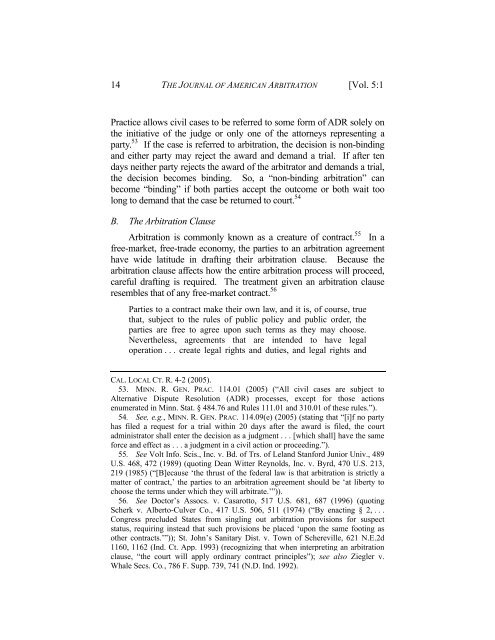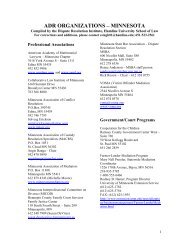2006/Vol. 5 No.1 - Hamline Law - Hamline University
2006/Vol. 5 No.1 - Hamline Law - Hamline University
2006/Vol. 5 No.1 - Hamline Law - Hamline University
You also want an ePaper? Increase the reach of your titles
YUMPU automatically turns print PDFs into web optimized ePapers that Google loves.
14 THE JOURNAL OF AMERICAN ARBITRATION [<strong>Vol</strong>. 5:1<br />
Practice allows civil cases to be referred to some form of ADR solely on<br />
the initiative of the judge or only one of the attorneys representing a<br />
party. 53 If the case is referred to arbitration, the decision is non-binding<br />
and either party may reject the award and demand a trial. If after ten<br />
days neither party rejects the award of the arbitrator and demands a trial,<br />
the decision becomes binding. So, a “non-binding arbitration” can<br />
become “binding” if both parties accept the outcome or both wait too<br />
long to demand that the case be returned to court. 54<br />
B. The Arbitration Clause<br />
Arbitration is commonly known as a creature of contract. 55 In a<br />
free-market, free-trade economy, the parties to an arbitration agreement<br />
have wide latitude in drafting their arbitration clause. Because the<br />
arbitration clause affects how the entire arbitration process will proceed,<br />
careful drafting is required. The treatment given an arbitration clause<br />
resembles that of any free-market contract. 56<br />
Parties to a contract make their own law, and it is, of course, true<br />
that, subject to the rules of public policy and public order, the<br />
parties are free to agree upon such terms as they may choose.<br />
Nevertheless, agreements that are intended to have legal<br />
operation . . . create legal rights and duties, and legal rights and<br />
CAL. LOCAL CT. R. 4-2 (2005).<br />
53. MINN. R. GEN. PRAC. 114.01 (2005) (“All civil cases are subject to<br />
Alternative Dispute Resolution (ADR) processes, except for those actions<br />
enumerated in Minn. Stat. § 484.76 and Rules 111.01 and 310.01 of these rules.”).<br />
54. See, e.g., MINN. R. GEN. PRAC. 114.09(e) (2005) (stating that “[i]f no party<br />
has filed a request for a trial within 20 days after the award is filed, the court<br />
administrator shall enter the decision as a judgment . . . [which shall] have the same<br />
force and effect as . . . a judgment in a civil action or proceeding.”).<br />
55. See <strong>Vol</strong>t Info. Scis., Inc. v. Bd. of Trs. of Leland Stanford Junior Univ., 489<br />
U.S. 468, 472 (1989) (quoting Dean Witter Reynolds, Inc. v. Byrd, 470 U.S. 213,<br />
219 (1985) (“[B]ecause ‘the thrust of the federal law is that arbitration is strictly a<br />
matter of contract,’ the parties to an arbitration agreement should be ‘at liberty to<br />
choose the terms under which they will arbitrate.’”)).<br />
56. See Doctor’s Assocs. v. Casarotto, 517 U.S. 681, 687 (1996) (quoting<br />
Scherk v. Alberto-Culver Co., 417 U.S. 506, 511 (1974) (“By enacting § 2, . . .<br />
Congress precluded States from singling out arbitration provisions for suspect<br />
status, requiring instead that such provisions be placed ‘upon the same footing as<br />
other contracts.’”)); St. John’s Sanitary Dist. v. Town of Schereville, 621 N.E.2d<br />
1160, 1162 (Ind. Ct. App. 1993) (recognizing that when interpreting an arbitration<br />
clause, “the court will apply ordinary contract principles”); see also Ziegler v.<br />
Whale Secs. Co., 786 F. Supp. 739, 741 (N.D. Ind. 1992).
















